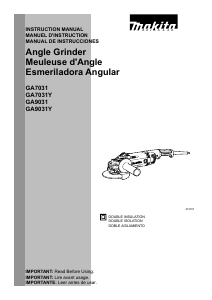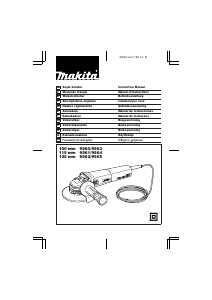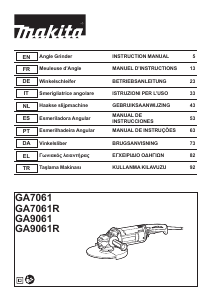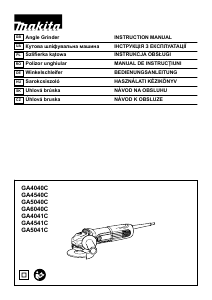Handleiding Makita DGA456 Haakse slijpmachine
Handleiding voor je Makita DGA456 Haakse slijpmachine nodig? Hieronder kun je de handleiding gratis bekijken en downloaden als PDF in het Nederlands en/of Engels. Dit product heeft 4 veelgestelde vragen, 0 comments en heeft 0 stemmen. Is dit niet de handleiding die je zoekt, neem dan contact met ons op.
Is je product kapot en biedt de handleiding geen oplossing meer? Dan kun je voor reparatie gratis terecht bij Repair Café.
Handleiding
Loading…


Loading…
Meer over deze handleiding
We begrijpen dat het prettig is om een papieren handleiding te hebben voor je Makita DGA456 Haakse slijpmachine. Je kunt de handleiding bij ons altijd downloaden en daarna zelf printen. Indien je graag een originele handleiding wilt hebben, raden we je aan contact op te nemen met Makita. Zij kunnen wellicht nog voorzien in een originele handleiding. Zoek je de handleiding van Makita DGA456 Haakse slijpmachine in een andere taal? Kies op de homepage je taal naar keuze en zoek daarna op het modelnummer om te zien of we deze beschikbaar hebben.
Specificaties
| Merk | Makita |
| Model | DGA456 |
| Categorie | Haakse slijpmachines |
| Bestandstype | |
| Bestandsgrootte | 8.34 MB |
Alle handleidingen voor Makita Haakse slijpmachines
Meer handleidingen voor Haakse slijpmachines
Veelgestelde vragen over Makita DGA456 Haakse slijpmachine
Ons supportteam zoekt dagelijks naar nuttige productinformatie en antwoorden op veelgestelde vragen. Als er onverhoopt toch een onjuistheid tussen onze veelgestelde vragen staat, laat het ons dan weten via het contactformulier.
Voor welk materiaal zijn haakse slijpmachines geschikt? Geverifieerd
Haakse slijpmachines zijn het meest geschikt voor slijpen van metaal of steen. Slijpmachines ontwikkelen veel warmte en zijn daardoor minder geschikt voor hout en kunststof.
Ik vind dit nuttig (65) Lees meerMoet ik gehoorbescherming dragen bij het gebruik van een haakse slijper? Geverifieerd
Dat is wel verstandig. Hoewel de hoeveelheid lawaai die een haakse slijper produceert verschilt per merk en model, kan langdurige blootstelling aan lawaai voor blijvende gehoorschade zorgen. Het is daarom goed om altijd gehoorbescherming te dragen.
Ik vind dit nuttig (16) Lees meerMoet ik oogbescherming dragen bij het gebruik van een haakse slijper? Geverifieerd
Ja. Bij het slijpen kunnen kleine restanten opvliegen. Als deze in een oog komen kan dit voor blijvende oogschade zorgen. Het is daarom nodig om altijd oogbescherming te dragen.
Ik vind dit nuttig (14) Lees meerKan ik elektrisch gereedschap in een schuur of garage opbergen? Geverifieerd
Over het algemeen kunt u elektrisch gereedschap in een schuur of garage opbergen, ook als het daar soms vriest. Voor de levensduur van het elektrisch gereedschap is het echter beter om het op een droge plaats zonder grote temperatuurschommelingen op te slaan. In een schuur of garage kunnen door temperatuurverschillen condensvorming ontstaan waardoor roest kan ontstaan. Bovendien gaan gereedschappen die op batterijen werken korter mee en laden ze minder goed op bij zeer lage temperaturen. Om er zeker van te zijn hoe uw elektrisch gereedschap moet worden opgeborgen, leest u altijd aandachtig de gebruikershandleiding.
Ik vind dit nuttig (8) Lees meerBeoordeling
Laat ons weten wat je van de Makita DGA456 Haakse slijpmachine vindt door een beoordeling achter te laten. Wil je je ervaringen met dit product delen of een vraag stellen? Laat dan een bericht achter onderaan de pagina.









Praat mee over dit product
Laat hier weten wat jij vindt van de Makita DGA456 Haakse slijpmachine. Als je een vraag hebt, lees dan eerst zorgvuldig de handleiding door. Een handleiding aanvragen kan via ons contactformulier.